Hurricane Michael
It’s amazing how little word has come out of the Gulf Coast in the aftermath of Hurricane Michael. That could be because much of the area is relatively isolated, and thankfully without a big population center (Panama City, to the west of ground zero Mexico Beach, has 37,000 residents). Still, the aerial images I’ve seen are scary, and reminiscent of what I saw first-hand in Homestead after Hurricane Andrew in 1992: a flattened war zone.
I know little of the greenhouse and nursery industry in that part of my home state, so I asked FNGLA head Ben Bolusky to see what he has heard from the organization’s Big Bend chapter. He replied thusly:
In the area where Hurricane Michael made landfall, power is out and will be for some time. Communications are still spotty because the storm took down as many as 70% of the cell towers in some counties. So, it’s challenging to get accurate reports. While there will likely be a loss of some plant material and scattered structural damage, there will be some business disruption for some. However, the nurseries have already been in clean-up mode—standing up plants and trees. The biggest need is power, followed quickly by the need for fuel to run generators so the irrigation systems can do as intended. FNGLA’s experience is it takes several days, sometimes even a few weeks, to assess the true extent of any damage or disruption.
Meanwhile, FNGLA and its chapters have sprung into action. Four staging areas have been established at FNGLA member nurseries (two in South Florida and two in Central Florida) to receive donations of supplies, materials and equipment. Over the next couple of days, donated trucks and drivers will deliver these materials to a couple of staging areas set up at FNGLA member nurseries in the Big Bend area. If it turns out there are more supplies than needed by FNGLA member businesses and their employees, then FNGLA’s Plan B is to coordinate with Florida State Rep. Halsey Beshears (and an FNGLA past president) for distribution to his constituents who were among the hardest hit. All of this underscores—yet again—the genuine caring and generosity of FNGLA’s members.
Amen to that, Ben! I know of no other state organization that is so well prepared to assist its members when dealing with the sort of natural disaster that is inevitable. (FNGLA even has a web page dedicated to hurricane preparedness and disaster relief.)
Looking more broadly, general agriculture in that region of the state appears to have taken a major hit, according to a report from the University of Florida. Some 1 million acres of field crops and 3.6 million acres of forest were potentially impacted. Cotton might be a total loss (yes, they grow cotton in Florida), as more than 90% of the crop was ready to harvest when Michael hit. Damage to winter vegetables, fruit and nut trees and our ornamental crops are still being assessed.
If you or someone you know was impacted by the storm, let us know and tell us how we can help! Email me at beytes@growertalks.com.

I’m distinguished!
Last week, I told you I was headed to Texas A&M University for a couple of days, but I didn’t say why. Well, our good friend Dr. Charlie Hall of Ellison Chair fame invited me to be this year’s “distinguished lecturer” at his annual Ellison Chair advisory committee meeting. That meant giving an hour-long talk to an eclectic mix of academics, students and committee members (many of whom are growers). I chose to focus on how to take advantage of some niches that I think offer opportunities in horticulture (you’ll be able to read more about that in my Acres & Acres column in the November GrowerTalks).
While there, I accompanied the committee members on a tour of the brand new Leach Teaching Garden, which opened in June. Named for major donors Tim and Amy Leach, graduates of the university, the first phase of the garden features 7 acres and 21 garden vignettes that give a wide range of ideas for yards and gardens, along with some agricultural education (seeing a center-pivot irrigation system up close, even just a 55-footer, was an eye-opener—those things are big!) and an events pavilion. It’s also home to the 12th largest post oak in the state. Joseph Johnson is director of the new garden, which will eventually cover 27 acres.
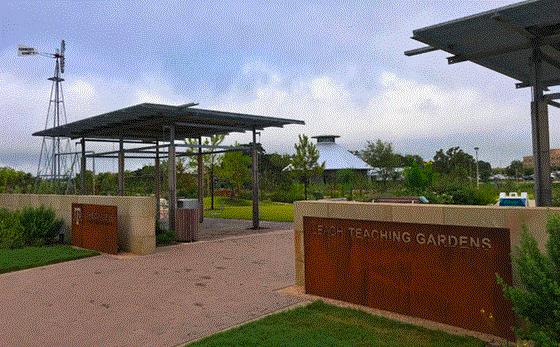

It’s TAMU’s first
Interestingly, TAMU, despite being a land-grant university, has never had an official garden. This one got its start in the late ’90s, when 40 acres of campus land was set aside for gardens and a greenway. Fundraising began about a decade ago, and now the project is in full swing.
One goal of the garden is to utilize the native soil (which isn’t great) and on-site water (which is high in salt), so the plant material will reflect what area homeowners can easily grow in their own yards. They’re also utilizing several methods of rain water collection. One cool one Joseph pointed out is called Water Fence: a 6-ft. high, 7-ft. long, 15 in. thick plastic tank that stands vertically like a fence panel. You can link them together, and cover them with any sort of wood or stone fencing to create an attractive water reservoir. Each tank holds 240 gallons of runoff, which you’d capture from a nearby roof and then use to irrigate your yard and garden.
What’s most fascinating is that it was invented by a 14-year-old, Steven McDowell, for a 9th grade science project in which he announced he was going to solve California’s drought problem. The project won numerous awards; Steven is now 18 (or 19) and holds a patent on his invention.
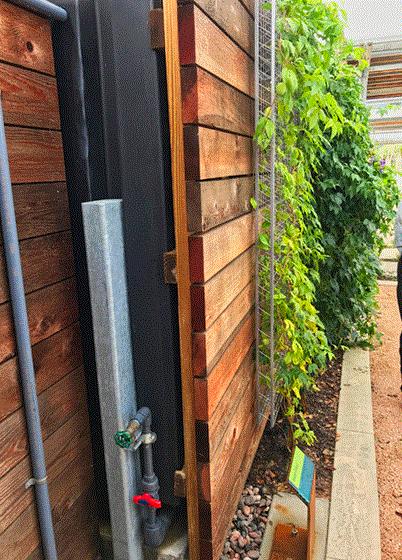
I also liked the attention to detail in the garden, such as this vegetable garden, which is surrounded by an authentic vintage-style double loop wire fence that pays homage to the German settlers who pioneered Texas farming and gardening.


The Human Behavior Lab
We were on our best behavior when we visited TAMU’s relatively new Human Behavior Lab, which they say is the largest-such university-based lab in the world (based on the number of folks they can test at one time). In it, they can do a wide range of “biometric research” in order to “get a comprehensive picture of the human decision-making process,” explained lab director Dr. Marco Palma. Biometric research means measuring eye tracking, facial expressions, heart rate, stress levels and so on to try to get inside the emotional and physical aspects of why we do what we do. The goals are myriad, from helping retailers sell better, to helping individuals make better decisions, such as sticking to a diet, and everything in between.
To see how it works, we became guinea pigs on an actual research project involving signage over plant displays and how we respond to varying size and placement of “Sale” signs and multiple pricing examples. (Personally, as an avid gardener and plant buyer, I was too busy noting if the herbs in the display were of adequate quality to care whether the “sale” sign over them was printed in black or red letters, so my answers were probably worthless. Still, they paid us each $20 for our time and effort, as they do with all lab subjects.)
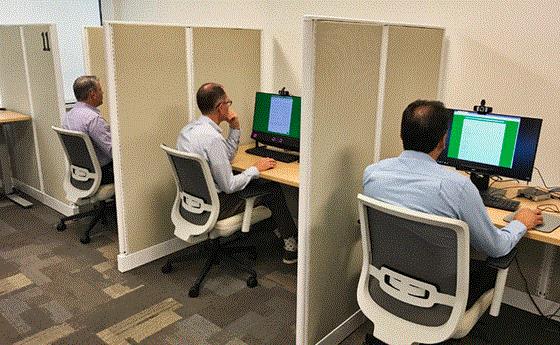
It’s fascinating, and it’s nice that much of what they are researching revolves around our products!

Botrytis webinar archived
This webinar hosting gig feels like another full-time job, what with all the ones I’ve done lately, and all the ones I have on the drawing board.
For instance, on Tuesday of this week I hosted one on behalf of sponsor Bayer on the topic, “New Research, New Innovation in Botrytis Management.” That one took not one but TWO experts, Drs. Janna Beckerman from Purdue and Aaron Palmateer of Bayer and the University of Florida, to cover thoroughly. Aaron went into great detail about Bayer’s new Broadform fungicide, which has some very interesting modes of action, including “mesostemic” activity or “vapor” redistribution (from the Trifloxystrobin component of the product). Fascinating!
Then there's one from a couple weeks ago on growing cannabis in a greenhouse vs. an indoor "grow."
You can sign up to watch the archived webinars (which now feature live video feeds of me and my guests!) at www.growertalks.com/webinars.
As for upcoming webinars, I'm working on two, one of which will be about biological controls. Stay tuned for details.

New Tesselaar variety comes to U.S.
Anthony Tesselaar is picky when it comes to new introductions, which is why they don’t happen often. After all, if you’re going to follow up on the success of Flower Carpet rose, canna Tropicanna and Volcano phlox, you’d better get it right!
Which is why I’m curious to try out daphne Perfume Princess, the newest Tesselaar variety to come to the U.S. Australian garden guru Don Burke called it “the best new plant to come out in Australia in the last 50 years. It’s that good.”
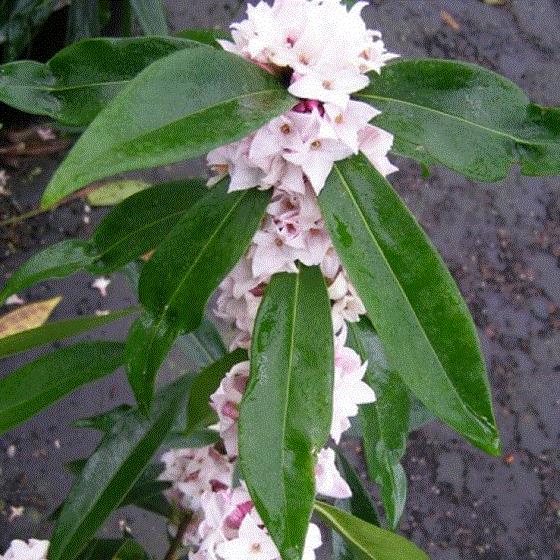
Launched in Australia in 2015 at the Melbourne International Flower Show, Perfume Princess has won a few awards to back up the claims, including “Plant of the Year” by the Australian Nursery and Garden Industry Association, the 2018 “Best New Ornamental Plant Variety” by Horticulture Week magazine in the UK, and the 2018 Gold Medal in Belfium’s Florall Award.
Perfume Princess was bred by New Zealand-based Mark Jury, who was determined to improve Daphne selections. His success came when he combined the tough growth habit of Daphne bholua types with the heady fragrance and flowering performance of Daphne odora. “It is just a brilliant plant to grow and a terrific nursery plant to produce,” Mark says. “That is not true of most Daphnes, which can be very difficult to produce in containers.” He goes on to explain “This is both the first and the last Daphne to bloom each year in our garden.”
Perfume Princess has a long flowering period and flowers from the tip all the way down the stem. Extremely tough and durable, it can withstand high temperatures, drought, humidity and waterlogging. The plant does not suffer the yellowing of leaves that’s so common in Daphne. It is also extremely vigorous, an excellent grower and responds very well to pruning. For instance, in three years of growing, Wyevale Nurseries in the UK says they haven’t lost a single plant.
We asked Tesselaar’s Global Operations Director Phillip Townshend about availability in the U.S.
“The plant has been trialed in multiple locations across the USA,” he told me via email, including Washington State, Oregon, California, Alabama and Florida. However, he says it’s still a relatively new program in the U.S. because his licenced growers have been a little slower to pick up the crop than those in Australia and Europe. Why?
“I think this is mainly due to the consumer familiarity in other markets with Daphne as a genus, and the difference in retailer customer bases between these markets and USA,” he says.
Currently, production of Perfume Princess is mainly on the West Coast, but will be expanding into other regions. He says Monrovia lists it on their website, and Matsuda’s Nursery has availability. Phillip adds, “We are still working through what happened to stock that was in production with Color Spot/Hines, but Village Nurseries and Treetown USA are licensed by Tesselaar, so I expect they will pick up the production on this program."
To learn more about Daphne Perfume Princess, go to www.tesselaar.com. For details on USA stock availability, contact Phillip Townshend at ptownshend@tesselaar.com.

Boxwood blight shipped to Indiana
Here’s some news we don’t like to hear: Boxwood blight made it into Indiana on a shipment of boxwood last May. The Indiana Department of Natural Resources (DNR) says that 23 stores (chains and IGCs) in Indiana received infected plant material from a nursery in Oregon, so it’s quite possible that plants were sold and are now out in the landscape. So far, DNR says the state hasn’t had the disease other than a few interceptions like this.
Indiana isn’t alone: reportedly, the crop was also sent to 11 other states.
Finally I ...
You know I think that clever and humorous videos are a great way to promote our products through viral spread on social media. Green Plants for Green Buildings must have gotten the memo because they’ve created a pair of quite clever TED-style videos promoting plants as “Nature’s game-changing technology for the modern workplace.
“It’s not a fake plant, or an iPlant. It’s a living plant, for the workplace of the future … no cords, no plugs, revolutionary mobile wireless technology, which means no charging, no batteries. Efficient, eco-friendly, solar- and hydro-powered technology.” Clever stuff!
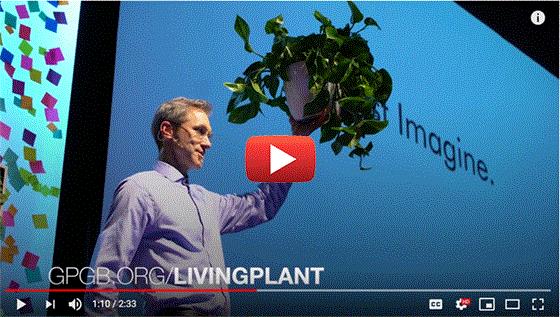
Part 2 might be even funnier.
“How did we get here? Good question. It started back around 2018. Our researchers went into offices all around the world and discovered that, despite first appearances, human beings are actually alive in the office space. Surprising, I know.”
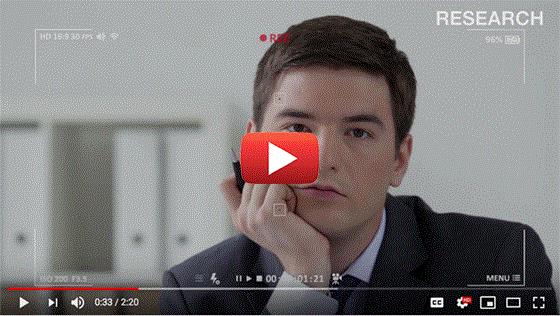
Check ‘em out, embed them on your company website and “spread them around like butter” (as my favorite YouTuber, Alex French Guy Cooking, says).
Finally II ...
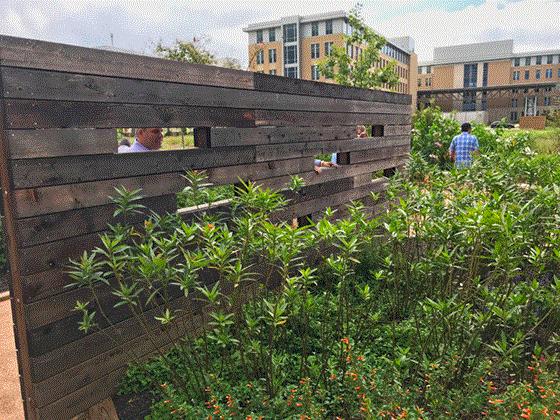
Here’s a nifty bird garden idea from the Leach Teaching Garden: A “bird blind” fence in your bird garden that lets you observe your fine-feathered friends without them knowing.
See you next time,

Chris Beytes
Editor
GrowerTalks and Green Profit
This e-mail received by 23,244 loyal readers!
Thanks to my loyal sponsors, who help me reach the 23,244 readers of Acres Online in 66 countries. Want to be one of them (a sponsor, that is)? Give Paul Black a shout and he'll hook you up.